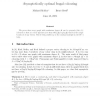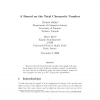SIAMDM
2010
14 years 7 months ago
2010
We prove that if T is a tree on n vertices with maximum degree and the edge probability p(n) satisfies: np C max{ log n, n } for some constant > 0, then with high probability...
111
click to vote
CORR
2010
Springer
14 years 7 months ago
2010
Springer
We study the edge-coloring problem in the message-passing model of distributed computing. This is one of the most fundamental problems in this area. Currently, the best-known dete...
130
Voted
COMBINATORICA
2010
14 years 9 months ago
2010
In this paper, we propose a simple and natural randomized algorithm to embed a tree T in a given graph G. The algorithm can be viewed as a "self-avoiding tree-indexed random ...
99
Voted
SIAMDM
2010
14 years 10 months ago
2010
Reed conjectured that for every ε > 0 and every integer ∆, there exists g such that the fractional total chromatic number of every graph with maximum degree ∆ and girth at...
105
Voted
JCT
2010
14 years 11 months ago
2010
We prove that every graph with maximum degree ∆ can be properly (∆ + 1)coloured so that no colour appears more than O(log ∆/ log log ∆) times in the neighbourhood of any v...
88
Voted
CORR
2010
Springer
14 years 11 months ago
2010
Springer
It is well known that the spectral radius of a tree whose maximum degree is ∆ cannot exceed 2 √
100
click to vote
ORL
2007
14 years 12 months ago
2007
We prove that it is NP-complete to decide whether a bipartite graph of maximum degree three on nk vertices can be partitioned into n paths of length k. Finally, we propose some ap...
123
Voted
COMBINATORICS
1999
15 years 3 days ago
1999
Let k denote the maximum degree of the kth iterated line graph Lk(G). For any connected graph G that is not a path, the inequality k+1 2k - 2 holds. Niepel, Knor, and Solt
106
Voted
COMBINATORICA
1998
15 years 4 days ago
1998
We prove that the total chromatic number of any graph with maximum degree is at most plus an absolute constant. In particular, we show that for su ciently large, the total chromat...
103
click to vote
DM
2002
15 years 7 days ago
2002
In 1993, Brualdi and Massey conjectured that every graph can be incidence colored with + 2 colors, where is the maximum degree of a graph. Although this conjecture was solved in ...


